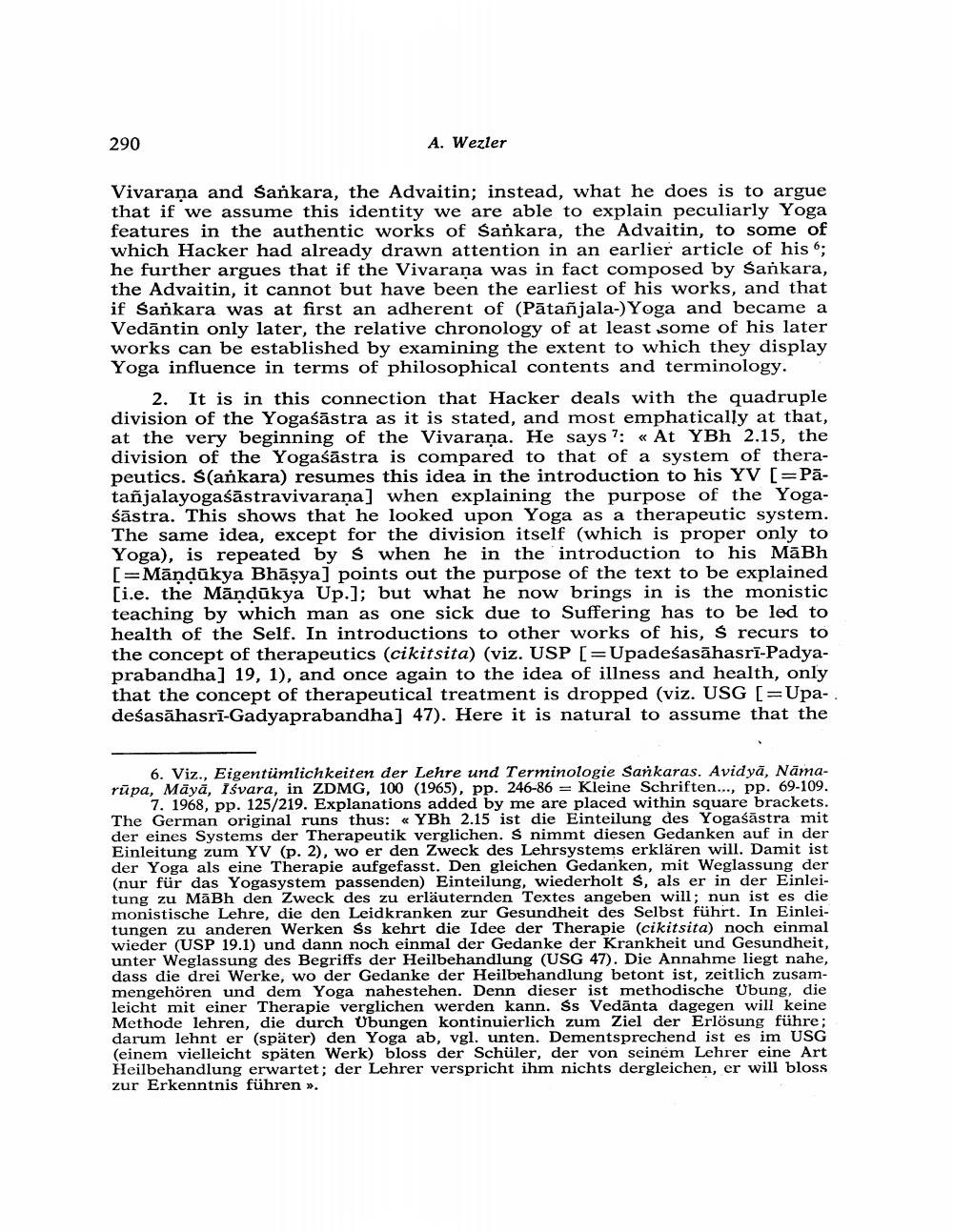Book Title: On Quadruple Division Of Yogasastra Author(s): A Wezler Publisher: A Wezler View full book textPage 2
________________ 290 A. Wezler Vivarana and Sankara, the Advaitin; instead, what he does is to argue that if we assume this identity we are able to explain peculiarly Yoga features in the authentic works of Sankara, the Advaitin, to some of which Hacker had already drawn attention in an earlier article of his 6; he further argues that if the Vivarana was in fact composed by Sankara, the Advaitin, it cannot but have been the earliest of his works, and that if Sankara was at first an adherent of (Patañjala-) Yoga and became a Vedāntin only later, the relative chronology of at least some of his later works can be established by examining the extent to which they display Yoga influence in terms of philosophical contents and terminology. 2. It is in this connection that Hacker deals with the quadruple division of the Yogaśāstra as it is stated, and most emphatically at that, at the very beginning of the Vivarana. He says ?: « At YBh 2.15, the division of the Yogaśāstra is compared to that of a system of therapeutics. S(ankara) resumes this idea in the introduction to his YV [=Pātañjalayogaśāstravivarana] when explaining the purpose of the Yogaśāstra. This shows that he looked upon Yoga as a therapeutic system. The same idea, except for the division itself (which is proper only to Yoga), is repeated by $ when he in the introduction to his MāBh [=Māņdükya Bhäsya] points out the purpose of the text to be explained [i.e. the Māndükya Up.]; but what he now brings in is the monistic teaching by which man as one sick due to Suffering has to be led to health of the Self. In introductions to other works of his, s recurs to the concept of therapeutics (cikitsita) (viz. USP [=Upadeśasāhasri-Padyaprabandha] 19, 1), and once again to the idea of illness and health, only that the concept of therapeutical treatment is dropped (viz. USG [=Upadeśasāhasrī-Gadyaprabandha] 47). Here it is natural to assume that the 6. Viz., Eigentümlichkeiten der Lehre und Terminologie Sankaras. Avidyā, Namarūpa, Māyā, Iśvara, in ZDMG, 100 (1965), pp. 246-86 = Kleine Schriften..., pp. 69-109. 7. 1968, pp. 125/219. Explanations added by me are placed within square brackets. The German original runs thus: «YBh 2.15 ist die Einteilung des Yogaśāstra mit der eines Systems der Therapeutik verglichen. s nimmt diesen Gedanken auf in der Einleitung zum YV (p. 2), wo er den Zweck des Lehrsystems erklären will. Damit ist der Yoga als eine Therapie aufgefasst. Den gleichen Gedanken, mit Weglassung der (nur für das Yogasystem passenden) Einteilung, wiederholt $, als er in der Einleitung zu MāBh den Zweck des zu erläuternden Textes angeben will; nun ist es die monistische Lehre, die den Leidkranken zur Gesundheit des Selbst führt. In Einleitungen zu anderen Werken Śs kehrt die Idee der Therapie (cikitsita) noch einmal wieder (USP 19.1) und dann noch einmal der Gedanke der Krankheit und Gesundheit, unter Weglassung des Begriffs der Heilbehandlung (USG 47). Die Annahme liegt nahe, dass die drei Werke, wo der Gedanke der Heilbehandlung betont ist, zeitlich zusammengehören und dem Yoga nahestehen. Denn dieser ist methodische Ubung, die leicht mit einer Therapie verglichen werden kann. Śs Vedānta dagegen will keine Methode lehren, die durch Ubungen kontinuierlich zum Ziel der Erlösung führe; darum lehnt er (später) den Yoga ab, vgl. unten. Dementsprechend ist es im USG (einem vielleicht späten Werk) bloss der Schüler, der von seinem Lehrer eine Art Heilbehandlung erwartet; der Lehrer verspricht ihm nichts dergleichen, er will bloss zur Erkenntnis führen »Page Navigation
1 2 3 4 5 6 7 8 9 10 11 12 13 14 15 16 17 18 19 20 21 22 ... 49
